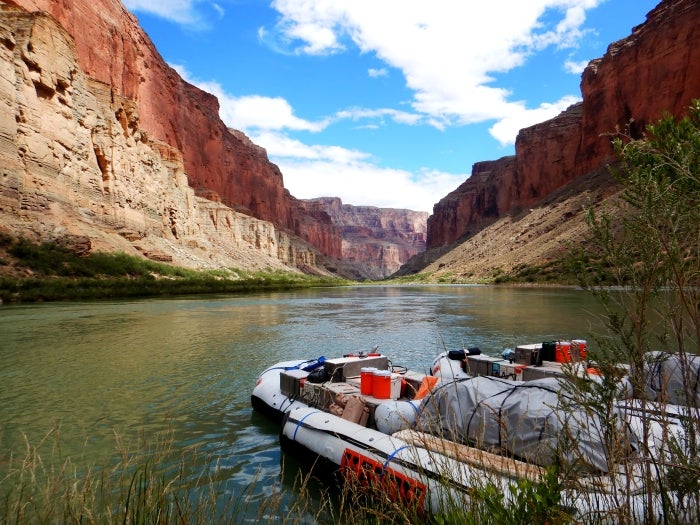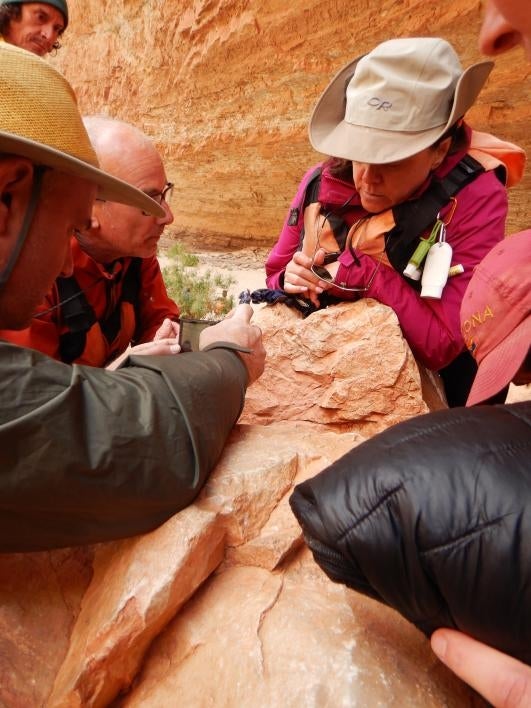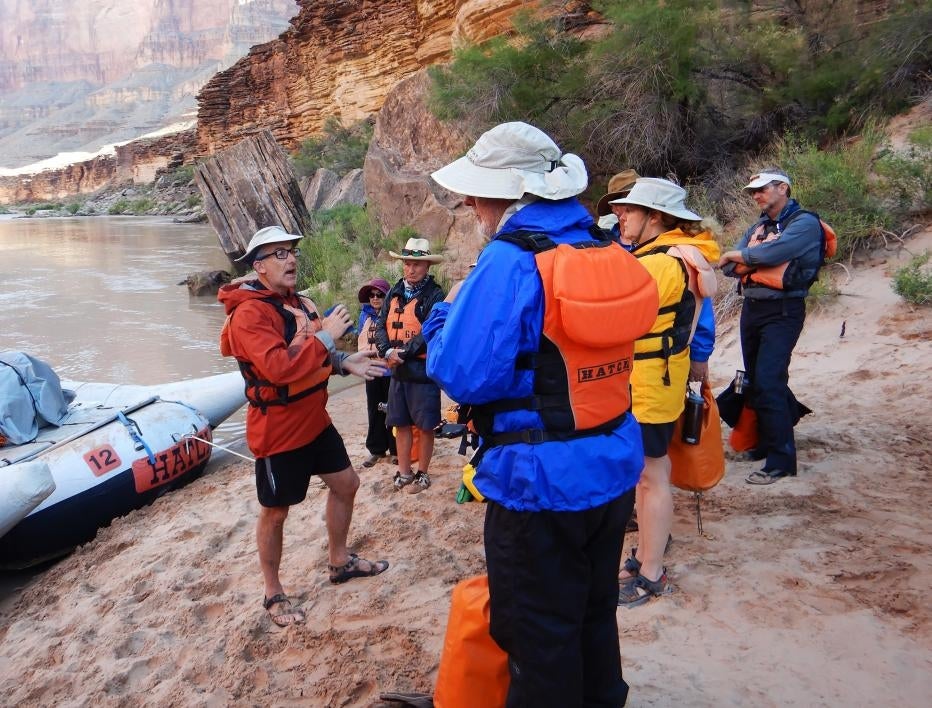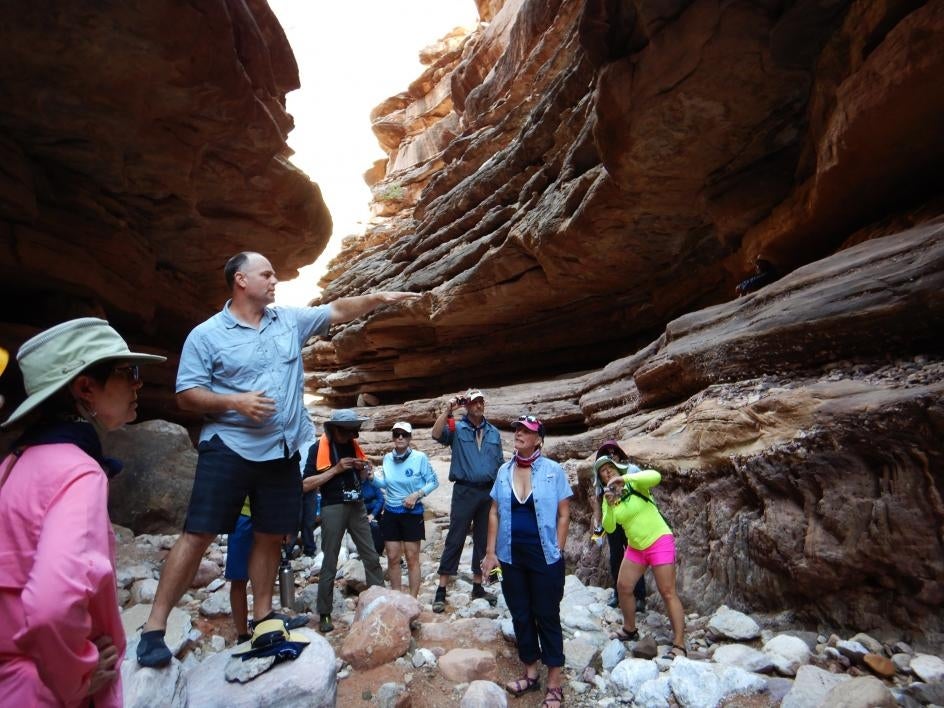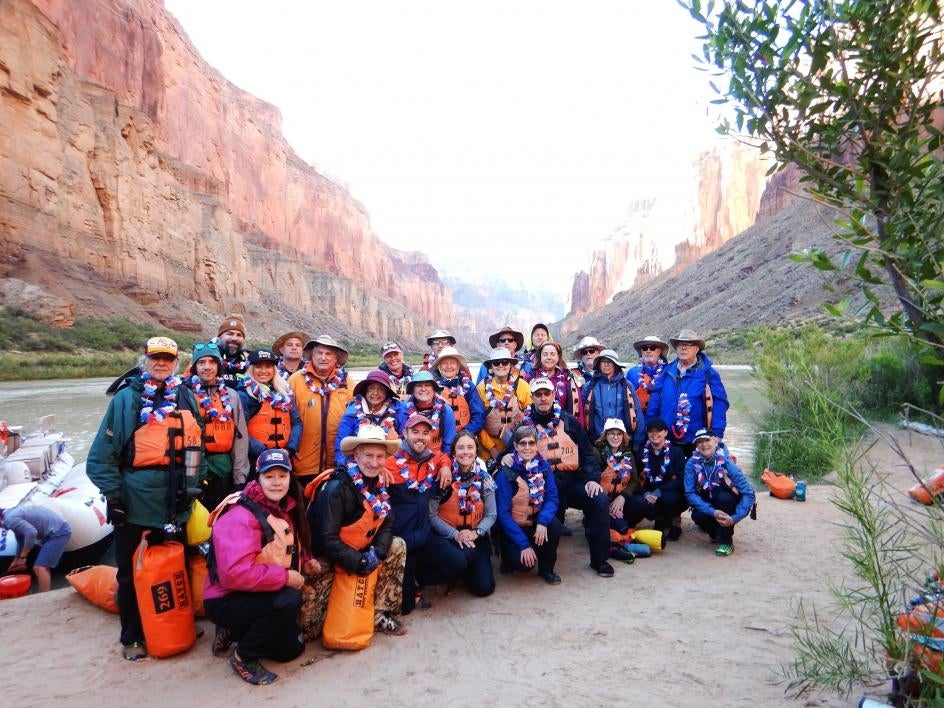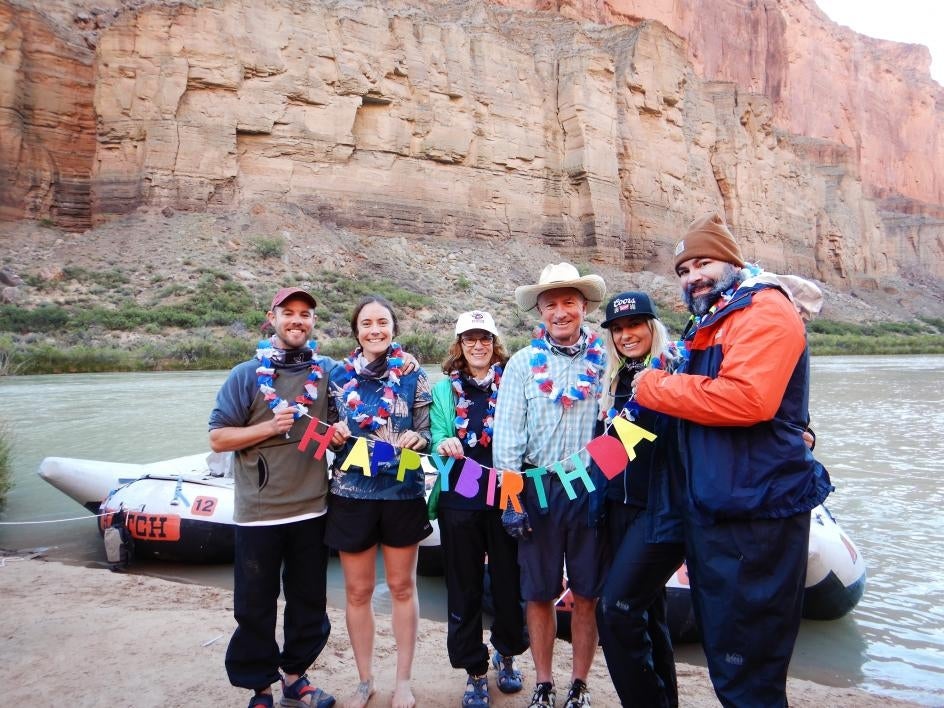It’s hard to imagine what the world looked like millions of years ago. But in Arizona, a journey through the Grand Canyon on the Colorado River gives a sense of how it might have felt.
Scientists believe the waterway began etching its path 5 to 6 million years ago to form what is now a mile-deep chasm in the Earth’s surface. But the rock layers it tore into date back 500 million years and encase the fossil remains of ancient life forms that are even older.
For researchers, the marbled canyon walls offer a fractured timeline of its history, from the earliest life forms it hosted to the ancestral remains of indigenous peoples who still inhabit it today.
In May, a Colorado River trip organized by the Institute of Human Origins, a research unit of The College of Liberal Arts and Sciences at Arizona State University, gave some 20 alumni, institute supporters and community members the chance to see that history through the eyes of ASU experts studying it.
Chris Campisano, an associate professor in The College’s School of Human Evolution and Social Change and an institute research associate on the trip, said understanding the Grand Canyon’s makeup serves as a basis to unravel broader quandaries about the geological world at large.
“You have 2 billion years of Earth history there,” Campisano said. “Individual layers of rock piece together to tell a much larger story about how sediments were being deposited in the canyon and speak to a larger framework of what was going on globally at the time.”
Understanding human history from the ground
Campisano was one of two ASU geologists who joined the weeklong river trip to break down the Grand Canyon’s geological significance for passengers. It is the latest destination in a travel outreach program bringing researchers and institute supporters together for trips to archeological hubs around the globe including Tanzania, the Galapagos Islands, Ethiopia and South Africa. Funds generated support the institute’s operations, scholarships and field and laboratory research.
This year’s Grand Canyon journey featured Campisano, an expert in ancient landscapes and evolution, and fellow geologist Ramon Arrowsmith, a professor in The College’s School of Earth and Space Exploration who specializes in geological faults and topography.
William Kimbel, the institute’s director, said faculty lead trips according to their area of expertise and highlight new research happening at the institute.
“All of our trips focus on one aspect of how humans developed on Earth, and put participants in a space with scientists who are able to bring that expertise,” he said. “Organizing a Colorado River trip through the Grand Canyon with two geologists is our way of adding educational value to a journey many have always wanted to take.”
Expeditions like these have become a legacy for the institute. Paleoanthropologist Donald Johanson Johanson is the Virginia M. Ullman Chair in Human Origins and a professor in the School of Human Evolution and Social Change in the College of Liberal Arts and Sciences.founded the operation in Berkeley, California, in 1981, just seven years after discovering the 3.18 million-year-old remains of Lucy, a fossil hominin thought to be an ancient ancestor to modern humans. He began leading public trips to sites of interest to human origins in the 1980s that continued after the institute moved to ASU in 1997.
Previous years have sent travelers to the Gombe Stream National Park, where groundbreaking primate researcher Jane Goodall spent decades studying chimpanzees, and the Ethiopian site Hadar, where Johanson himself uncovered Lucy in 1974.
But this year’s Grand Canyon trip marked the first to take place locally, a change Kimbel hoped would make the institute’s activities more accessible.
“This is an Arizona trip, and I think that makes it available to a larger audience than some of our international trips,” he said.
Casting a wider net
That was the case for Bryne Broderick, an alumna who graduated with a degree in physical anthropology in 1996, just a year before the institute came to ASU. As an undergraduate, she’d originally wanted to study geology and said taking part in the institute’s expeditions abroad intrigued her, but felt out of reach. Going to the Grand Canyon on this trip was a way to return to a scientific passion she fostered at ASU.
“Listening to Ramon explain the rock layers and the different processes that formed the canyon really tapped into my love of geology, because it provided an actual experience to reference,” said Broderick, who now works as a radiologist in Michigan. “I think it was also special that people on the trip came from so many different walks of life; it spoke to the fact that anyone with an interest in the natural world can feel like they have a place on trips like these.”
For Arrowsmith, the trip was the most recent in a lineup of academic endeavors on the Colorado River that began under the mentorship of the late Troy Péwé, an emeritus professor of geology at ASU who spent decades researching the Grand Canyon.
Not long after Arrowsmith joined ASU as an assistant professor in 1995, Péwé invited him to join an annual river trip for undergraduate students to conduct research. From pointing out fossil-rich slot canyons to identifying walls with rock dating back almost 1 billion years, he said what he learned from Péwé informs the history he relays to new passengers today.
“I think Péwé taught the importance of having that enthusiasm for telling the story of the Grand Canyon on multiple levels; from its geology to the sweeping Earth history that it holds,” he said.
Millions of visitors from around the world visit the site today, which celebrated its centennial as a national monument this year. As part of a public institution in Arizona, Arrowsmith said it’s also important to continue finding ways to educate the public about the geological wonder in their backyards.
“When you meet somebody on the other side of the world and you tell them you live in Arizona, one of the first things they will mention is the Grand Canyon,” he said. “At ASU, we have a responsibility to dig deeper to help people learn more about the natural world and how to preserve it.”
Top video: Passengers taking part in The College’s Institute of Human Origins’ Colorado River trip floated through the Grand Canyon alongside two ASU geologists this summer, part of an institute outreach program sending participants to archeological hotspots around the world. Video by Julie Russ.
More Science and technology

Real AI solutions helping people now
AI may be everywhere, but its impacts on day-to-day life are more surprising — and beneficial — than you might realize. From scanning thousands of images to prevent crop shortages to creating …
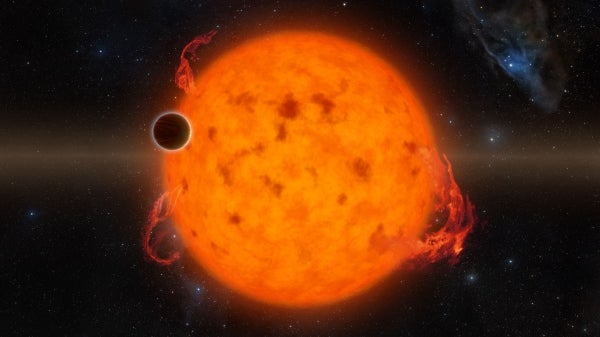
ASU forges strategic partnership to solve the mystery of planet formation
Astronomers have long grappled with the question, “How do planets form?” A new collaboration among Arizona State University, Michigan State University and Lawrence Livermore National Laboratory will…

AI for AZ: ABOR funds new tools for state emergency response
A huge wildfire rages in the wilderness of Arizona’s White Mountains. The blaze scorches asphalt and damages area bridges, causing traffic accidents when residents attempt to evacuate. As hospitals…

